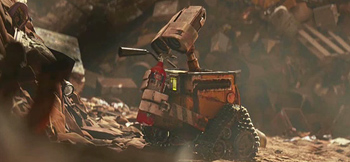In the Disney Pixar movie Wall-E, the three act structure is used in much the same way. The first act is where Wall-E (the main protagonist) is introduced. Without knowing much about him, the viewer follows him as he goes about his day, which prompts the question as to how his world came to look the way it is now. The tricky part about this movie following the three act structure, is that Wall-E doesn't speak a word until a second character comes into the story, making the question he is asking a little bit harder to discern.
The second point in the movie Wall-E is whenever he enters on the ship. While doing a bit of detective work, Wall-E discovers a video which shows him why his world is full of trash. Whenever trash became too large of a problem on Earth, many of the inhabitants were sent onto a ship for "just a few years" in order to clean up what they had left behind. The video later informs the protagonist that there was a problem with the clean-up effort and those living on the ship were never designed to return to Earth. The question Wall-E is now presented with is how he can work to fix what happened to his home planet.



I like your explanation.
ReplyDeleteUnfortunately it's wrong though. Like all good films, Wall-E is about character, not concept. Humanity and the polluted earth are just back story, for us the audience, the central plot is a love story.
ReplyDeleteIn the first ten-minutes, we're introduced to Wall-E as an anthropomorphic robot who is lonely. The incident that changes everything is the arrival of a second robot, whom Wall-E attempts to befriend. The remainder of the 1st Act deals with the increasing complications of this burgeoning relationship but Wall-E's life has changed. He is no longer alone.
Until of course, Eve is taken away. An event Wall-E fights by pursuing her relentlessly. The second act is packed with superbly crafted exposition where we learn about the future of humanity - and why the plant holds such importance - but the plot focuses on Wall-E's continued infatuation with Eve. At the climax of the second act, a twist; the plant has vanished, and we discover that the Axium robots are trying to destroy it, from here the two stories intertwine more clearly, but by the end of the second act: Eve, learning about everything Wall-E has done, returns his feelings (the dance) and Wall-E is reunited with her.
From then, the third act is about them returning the plant to the Axium, and the steadily increasing obstacles that stand in their way, thanks to the Axium autopilot. The final obstacle with the highest stakes happens when Wall-E is damaged. Now Eve must return the plant, because Earth is the only place with the spare parts needed to save him.
Technically Wall-E's life was in the same danger at the 2nd act climax, but it seems to work because not only is Wall-E's life in danger, but the loss of their new-found love is at stake too.
It is an incredibly simple plot structure, well thought out, with lots of depth and beautifully told.